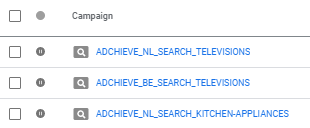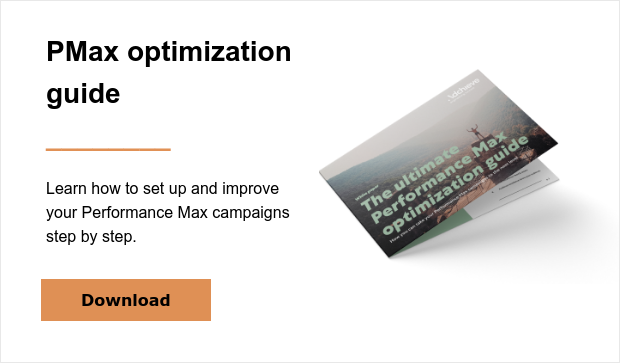Tip: download our Performance Max white paper to learn more about this important new Google Ads Campaign Type.
Reasons why a good naming convention is important in Google Ads
You probably recognize the image, but anyway, I will first show you what a naming convention looks like in Ads:

Building a good Google Ads naming convention is of great importance for five reasons. You need a good naming convention to be able to quickly filter so that everyone can easily analyze the campaigns.
I explain these reasons below:
- Quick overview: If you later want to quickly see how a campaign is structured (channels, target groups and keywords), retrieving it takes a lot of time if the campaign has a generic name such as campaign # 1.
- Filtering data: Sometimes you want to quickly filter by country or channel, but there are several campaigns targeting the same country or channel. If you include this in the campaign name, you can quickly search for it in Google Ads. For example, with a filter on “UK” you can see all the important metrics of the different campaigns targeting the United Kingdom.

- Multiple managers in your account: If different people work in a Google Ads account, it is useful for the campaigns to be built consistently. This allows any manager to quickly analyze and compare campaign performance.
- Analyze: with a good Google Ads naming convention, you can quickly analyze campaigns. For example, do you download data to Excel? Then you can more easily distinguish Search campaigns from shopping campaigns if this is mentioned in your campaign name.
Naming convention: eight best practises
Almost every SEA specialist has his or her preference for a good campaign name. So there is no right or wrong in terms of structures; as long as you are consistent.
An example of a good Google Ads naming convention, as you can also see in the Google Ads print screen above, is:

There are generally 8 best practices that every SEA specialist applies:
- Consistency (over-account): Try to maintain the same structure in your account (s) so that you can easily compare data. Make sure the order and characters you use are the same within and between your accounts.
- In English: By using English, you create consistency, and you can be sure that most (international) specialists can quickly understand how the campaign is structured.
- Capitalization: Preferably only use uppercase or lowercase letters. Google Ads is case sensitive.
Do you use the Google Ads API or the Google Ads Editor? (Note: this is generally still little used with the rise of PCC management software.) Be aware that if you use an incorrect campaign or ad name, you may receive error messages, or a new ad group will be created without your consent.
- Abbreviations: Be cautious about using abbreviations. Not everyone is familiar with certain abbreviations and this certainly applies to cooperation in an international context. Some abbreviations such as country codes (Google on “ISO country codes”) are more widely known.
- Length: Avoid long campaign names. Columns are sometimes truncated in length and make an account less clear. This makes it more difficult to interpret the content. Use a maximum of 50 characters as a guide.
- Spaces: Avoid spaces. Spaces are sometimes difficult to see with the naked eye. It is often unclear whether there are 1 or 2 spaces. Do you want to break up concepts? Then use other signs. For example, use underscores to break up specific terms and hyphens for terms that consist of several words.
- Deleted campaigns: Are you deleting a campaign? Then you can never use this name again. It is therefore advisable to change the name first. Before you delete a campaign, for example, put “ZZ_” before the campaign name. This way you ensure that this campaign is listed alphabetically at the bottom and you can filter on it more easily. In addition, you can use a strong name again in the future.
- Descriptive: Finally, a naming convention must of course provide a clear description of what is in the Google Ads campaign. The structure is strongly dependent on the chosen campaign structure and personal preferences. Here you can include the following components:
a. PPC Management Tool: Do you use a PPC or feed management tool like Adchieve? Then I advise placing the name of this tool at the front of the campaign name, so that you can quickly see how the campaign is being managed.
b. Country: Indicate in which country the campaign is targeted. Often accounts are already classified by country, but if you have exported the data to a spreadsheet, it is not immediately clear which country the figures are for. If you split cells, you can filter on a part of the cell, for example country name. If this is in the campaign name, you can immediately view the figures per country.
c. Campaign type: indicate what type of campaign is involved. As a result, you can quickly see what type of ad is involved and on which channels the ads run. Campaign types can be, for example: search, shopping, smart shopping, display, YouTube, hotel ads, showcase, universal app, smart campaigns, Gmail ads or campaign types outside the Google networks such as Amazon Sponsored Products, Facebook or Pinterest.
d. Theme: The theme of the campaign shows which products, product groups, or brands a campaign targets. You can also indicate whether it is a campaign related to your own brand (branded) or generic keywords (non-branded). This is useful because branded campaigns often have different objectives, and you can also interpret the campaign performance differently. You can measure that with the incremental uplift.
e. Other elements: some SEA specialists split up their campaigns even further. This is often done on the basis of device type, match type or target group. If you break down a campaign further, it is important that you also include this in your name so that other Google Ads managers quickly see that the campaign only targets a limited part of the search traffic.
Conclusion: With a good name you make a profit in multiple areas
A good naming convention is important for managing your Google Ads campaigns (or others, for example the new Amazon Ads) in the context of overview, collaboration, saving time and preventing errors or error messages.
I will cite the example I cited above and, with the best practices in mind, once again explain why this is a good naming convention (note: you obviously cannot include colors in Ads campaigns, I use them here purely for clarification):

The campaigns are structured in the following way:
Feed management tool _ country code _ campaign type _ theme. Then you can add other elements to that.
The above example is also consistent, in English, reserved in abbreviations, not too long and does not use spaces. Concepts are constructed with underscores and multi-word themes use a hyphen.
Do you have any questions, comments, tips, or tricks that you would like to share with me? I would love to hear from you.
Tip: download our Performance Max white paper to learn more about this important new Google Ads Campaign Type.


